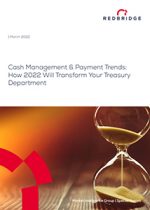
Cash Management & Payment Trends: How 2022 Will Transform Your Treasury Department
Our team provides useful information to industry practitioners, through various articles, studies and research.
A growing number of businesses are transitioning from traditional Lockbox payments to Automated Clearing House (ACH) payments to streamline their payment operations. This strategic shift not only optimizes transaction speed and accuracy but also significantly enhances overall financial management. At Redbridge, we’ve helped many companies make the switch and have identified the best ways to streamline the process.
Houston, Texas — Redbridge Debt and Treasury Advisory (DTA) is pleased to announce the formation of Redbridge Global Markets, LLC, a new broker-dealer subsidiary specializing in capital markets transactions and other strategic advice. Registered with the Securities and Exchange Commission (SEC) and the States of Texas, Michigan, and New York, as well as a member of the Financial Industry Regulatory Authority (FINRA) and Securities Investor Protection Corporation (SIPC), this strategic expansion strengthens Redbridge DTA’s position as a trusted partner and accelerates its growth in the U.S. corporate finance sector.
Facing fluctuating interest rates, businesses today confront the dual challenge of planning for periods of both hikes and declines. Federal Reserve rate increases to combat inflation as well as current market predictions of potential decreases create economic unpredictability for businesses like yours.
HawkeyeBSB is now available in the Coupa App Marketplace, extending Coupa’s platform and increasing efficiency in bank fee management for global enterprises.
Treasurers are at the forefront of financial management, juggling a myriad of tasks that span from ensuring liquidity to assessing financial risks and optimizing capital for future growth. This is not just routine work; it is a quest for fiscal responsibility in a world where every penny counts. That said, amid the hustle of finance management, a critical challenge often goes unnoticed: bank fee analysis
Updated May 14, 2024: In an Order dated May 14, 2024, the Court granted an extension of the claims-filing deadline. The deadline to submit claims is August 30, 2024.
High interest rate environments have created opportunities for companies to significantly increase their treasury revenues through investable balances while reducing bank fees from bank cash balance offsets. As such, banks are pushing their clients to invest their cash balances in money market funds, but alternative investment vehicles may offer more optimal returns on investment.
Our treasury consulting team recently invited six vendors: Cegid, Diapason, FIS, Kyriba, Neofi, and Sage to a workshop focused on the migration to ISO 20022. At this event, they sat down with our experts, Iris Rousselière and Jéromine Adler and discussed their thoughts on this transition as well as how companies can benefit from it.
The recent banking turmoil reminds everyone just how important it is to be managing counter party risk. This disarray also demonstrates the strategic nature of deposits for financial institutions. According to Alexandre Bousquenaud, one of the key objectives treasurers should focus on in this environment is negotiating their yield on cash balances to take advantage of ongoing monetary tightening.
In 2022, Didier Philouze, Head of Debt Advisory at Redbridge, and his team raised more than €10 billion of financing. In this interview he looks back at the past year in the debt markets and considers what may be to come in 2023.